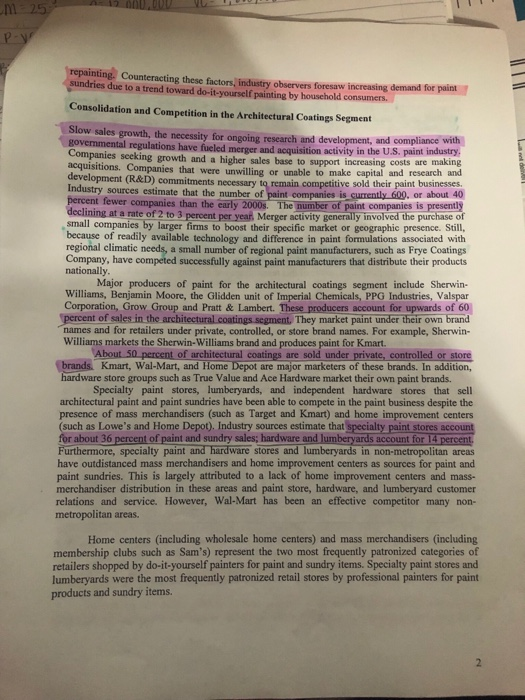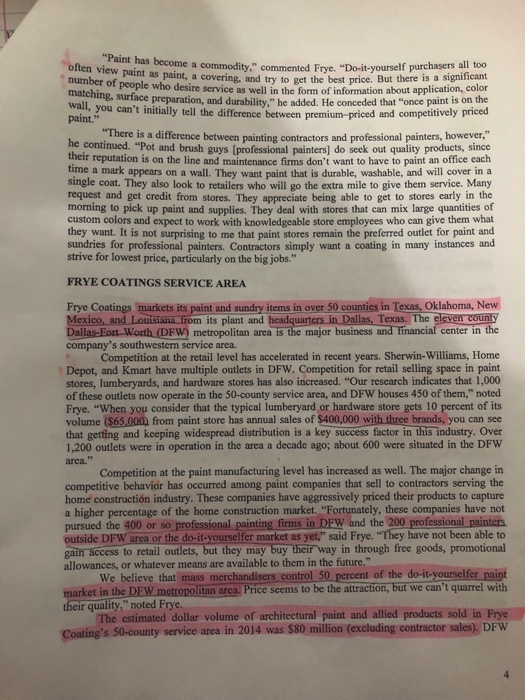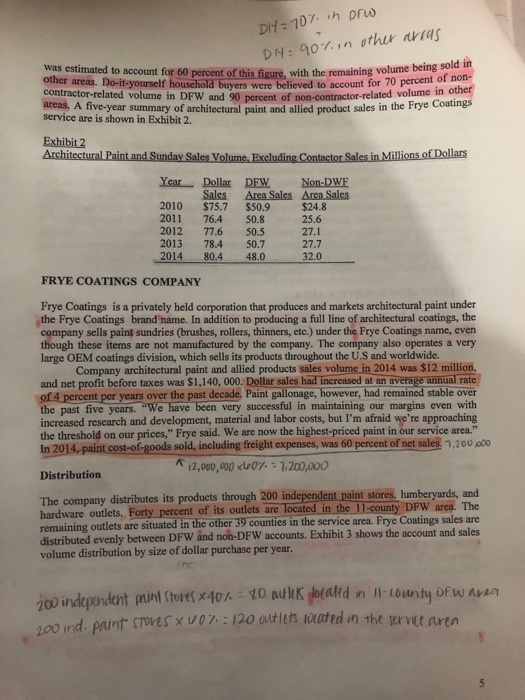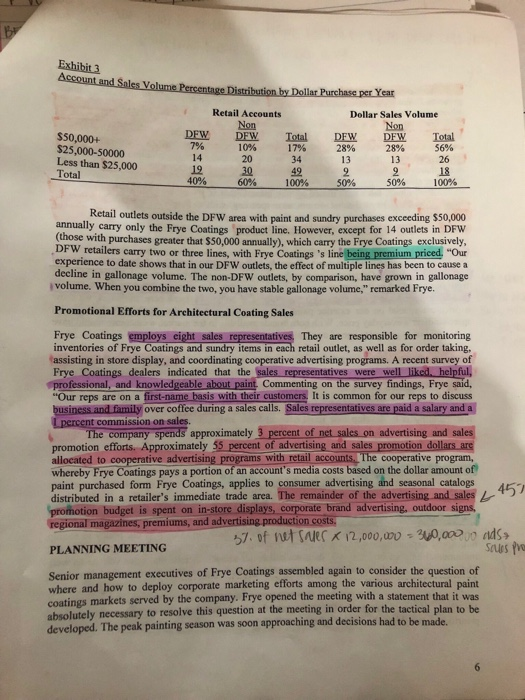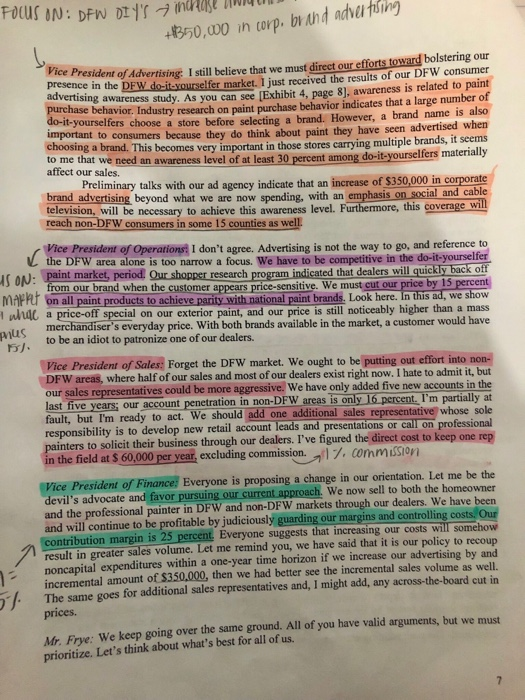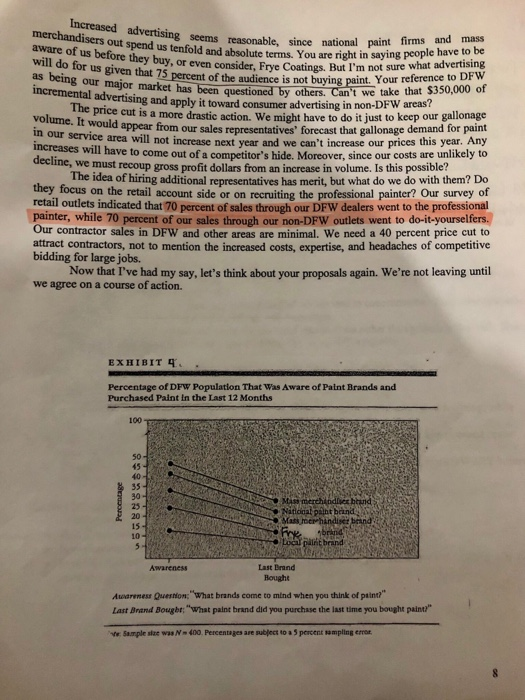The decision problem is first to identify the more attractive segments, and second to determine an effective method to increase sales to the preferred segment(s).
Which decision is the best option that will increase sales and why. Please show all work.
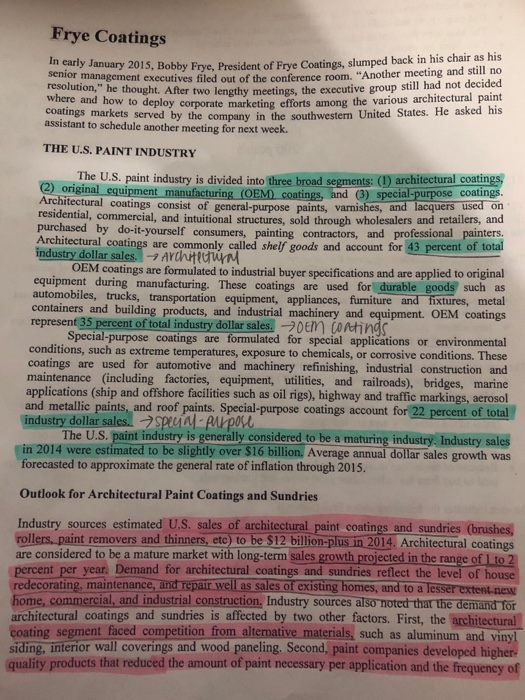
Frye Coatings 015, Bobby Frye, President of Frye Coatings, slumped back in his chair as his of the conference room. "Another meeting and still no In early January 2 senior management executives filed out t. After two lengthy meetings, the executive group still had not decided efforts among the various architectural paint he t where and how to deploy corporate marketing coatings markets served by the company in the southwestern United States. He asked his assistant to schedule another meeting for next week. THE U.S. PAINT INDUSTRY The U.S. paint industry is divided into three broad segments: (1) architectural coatings riginal equipment manufacturing (OEM) coatings, and (3) special-purpose coatings ecuiral coatings consist of general-purpose paints, varnishes, and lacquers used on residential, commercial, and intuitional structures, sold through wholesalers and retailers, and consumers, painting contractors, and professional painters. tota Architectural coatings are commonly called shelf goods and account for 43 percent o industry dollar sales. -Ayht OEM coatings are formulated to industrial buyer specifications and are applied to original such as automobiles, trucks, transportation equipment, appliances, furniture and fixtures, metal containers and building products, and industrial machinery and equipment. OEM coatings equipment during manufacturing. These coatings are used for durable represent 35 percent of total industry dollar sales. oen co Special-purpose coatings are formulated for special applications or environmental onditions, such as extreme temperatures, exposure to chemicals, or corrosive conditions. These coatings are used for automotive and machinery refinishing, industrial construction and maintenance (including factories, equipment, utilities, and railroads), bridges, marine applications (ship and offshore facilities such as oil rigs), highway and traffic markings, aerosol and metallic paints, and roof pai industry dollar sales. SP PAwpou nts. Special-purpose coatings account for 22 percent of total The U.S, paint induistry is generally considered to be a maturing industry, Industry sales in 2014 were estimated to be slightly over $16 billion. Average annual dollar sales growth was forecasted to approximate the general rate of inflation through 201S Outlook for Architectural Paint Coatings and Sundries Industry sources estimated U.S. sales of architectural rollers, paint removers and thinners, etc to be $12 billion-plus in 2014. Architectural coatings are considered to be a mature market with long-term sales growth projected in the range o percent per year. Demand for architectural coatings and sundries reflect the level of paint coatings and sundries (brushes, ho orating, maintenance, and repair well as sales of existing homes, and to a extent new emand for industrial construction, Industry sources a architectural coatings and sundries is affected by two other factors. First, the architec ome, commercial, and competition from alternative materials, such as aluminum and viny coating segment faced siding, interior wall coverings and wood paneling. Second, paint companies developed hi quality products that reduced the amount of paint necessary per application and the frequency of repainting. Counteracting these factors, industry observers foresaw increasing demand for paint sundries due to a trend toward do-it-yourself painting by household consumers Consolidation and Competition in the Architectural Coatings Segment Slow sales growth, the necessity for ongoing research and development, and compliance govemmental regulations have fueled merger and acquisition activity in the U.S. paint Companies seeking growth and a higher sales base to support increasing co with sts are makin that were unwilling or unable to make capital and research and (R&D) commitments necessary to remain competitive sold their paint businesses. Industry sources estimate that the number of paint companies is currently 600, or about 40 percent fewer companies than the early 2000s. The number of paint companies is presently eclining at a rate of 2 to 3 percent per year, Merger activity generally involved the purchase of small companies by larger firms to boost their specific market or geographic presence. Still, because of readily available technology and difference in paint formulations associated with regional climatic needs, a small number of regional paint manufacturers, such as Frye Coatings Company, have competed successfully against paint manufacturers that distribute their products nationally Major producers of paint for the architectural coatings segment include Sherwin- Williams, Benjamin Moore, the Glidden unit of Imperial Chemicals, PPG Industries, Valspar Corporation, Grow Group and Pratt &Lambert. These producers account for upwards of 60 percent of sales in the architectural.coatings segment, They market paint under their own brand names and for retailers under private, controlled, or store brand names. For example, Sherwin- Williams markets the Sherwin-Williams brand and produces paint for Kmart. About 50 percent of architectural coatings are sold under private, controlled or store brands. Kmart, Wal-Mart, and Home Depot are major marketers of these brands. In addition, hardware store groups such as True Value and Ace Hardware market their own paint brands. Specialty paint stores, lumberyards, and independent hardware stores that sell architectural paint and paint sundries have been able to compete in the paint business despite the presence of mass merchandisers (such as Target and Kmart) and home improvement centers (such as Lowe's and Home Depot). Industry sources estimate that specialt for about 36 percent of paint and sundry sales; hardware and lum stores Furthermore, specialty paint and hardware stores and lumbery non-metropolitan areas have outdistanced mass merchandisers and home improvement centers as sources for paint and paint sundries. This is largely attributed to a lack of home improvement centers and mass- merchandiser distribution in these areas and paint store, hardware, and lumberyard customer relations and service. However, Wal-Mart has been an effective competitor many non- metropolitan areas. Home centers (including wholesale home centers) and mass merchandisers (including membership clubs such as Sam's) represent the two most frequently patronized categories of retailers shopped by do-it-yourself painters for paint and sundry items. Specialty paint stores and lumberyards were the most frequently patronized retail stores by professional painters for paint products and sundry items. Architectural Coatings Purchase Behavior Approximately 50 percent of architectural coatings dollar sale are acc yourselfer painters. Professional painter purchases account for 25 percent oud remainder of architectural coatings dollar sales results from government, exports ahid 25 percent of dollar sales. The and contractor for interior paints. Exterior percent of sales. Lacquers and all other applications make up the balance of Almost 60 percent of annual architectural coatings sales are paint represents 38 sales. Slightly less than one in four households purchase interior house paint in any giv en year. than that for The percentage of households purchasing exterior house paint is considerably less interior paint. The popularity of do-it-yourself painting, particularly for interior app increased the paint and sundry item product line carried by retail outlets. Paint industry consumer research indicates that the average dollar paint purchase per purchase occasion is a The average dollar sundry purchase per occasion is about $28.21 bout $174.00. that do-it-yourself Research by the Home Improvement Research Institute indicates that do-it-yo painters first choose a retail outlet for paint and paint sundries, then choose a paint research also identified four steps in the do-it-yourself decision process for home improvement products, including paint. The results of this research are summarized in Exhibit 1. EXHIBIT 1 Consumer Buying Decision Process for Home Improvement Products Step 4 Step 3 Step 2 Step 1 Garhet Decide or Motystion tee dime Consumer iteratare "Paint has become a commodity." commented Frye. "Do-it-yourself p view paint purchasers all apaint, a covering, and try to get the best price. But there is a significant of people who desire service as well in the form of information about application, color matching, surface preparation, and durability," he added. He conceded that "once paint is on the , you can't initially tell the difference between premium-priced and competitively priced paint." "There is a difference between painting contractors and professional painters, however," he continued. "Pot and brush guys [professional painters] do seek out quality products, since their reputation is on the line and maintenance firms don't want to have to paint an office each time a mark appears on a wall. They want paint that is durable, washable, and will cover in a single coat. They also look to retailers who will go the extra mile to give them service. Many request and get credit from stores. They appreciate being able to get to stores early in the morning to pick up paint and supplies. They deal with stores that can mix large quantities of custom colors and expect to work with knowledgeable store employees who can give them what they want. It is not surprising to me that paint stores remain the preferred outlet for paint and sundries for professional painters. Contractors simply want a coating in many instances and strive for lowest price, particularly on the big jobs." FRYE COATINGS SERVICE AREA Frye Coatings markets its paint and sundry items in over 50 counties in Texas, Oklahoma, New Dallas, Texas. The its plant and Dallas-Fort Worth (DFW) metropolitan area is the major business and financial center in the company's southwestern service area. Competition at the retail level has accelerated in recent years. Sherwin-Williams, Home Depot, and Kmart have multiple outlets in DFW. Competition for retail selling space in paint stores, lumberyards, and hardware stores has also increased. "Our research indicates that 1,00 of these outlets now operate in the 50-county service area, and DFW houses 450 of them," noted Frye. "When you consider that the typical lumberyard or hardware store gets 10 percent of its volume ($65.00m from paint store has annual sales of $400,000 with three brands, you can see that getting and keeping widespread distribution is a key success factor in this industry. Over 1,200 outlets were in operation in the area a decade ago; about 600 were situated in the DFW area. Competition at the paint manufacturing level has increased as well. The major change in competitive behavior has occurred among paint companies that sell to contractors serving the home constructin industry. These companies have aggressively priced their products to capture a higher percentage of the home construction market. "Fortunately, these companies have not pursued the 400 or so professional painting firms in DFW and the 200 professional painters utside DFW area or the do-it-yourselfer market as yet," said Frye. "They have not been able to gain access to retail outlets, but they may buy their way in through free goods, promotional allowances, or whatever means are available to them in the future." We believe that mass merchandisers control 50 percent of the do-it-yourselfer paint market in the DEW metropolitan area Price seems to be the attraction, but we can't quarrel with their quality," noted Frye The estimated dollar volume of architectural paint and allied products sold in Frye Coating's 50-county service area in 2014 was $80 million (excluding contractor sales). DFW DIY 107 h Drw was estimated to account for 60 percent of this figure, with the remaining volume being sold in uyers were believed to account for 70 percent of non- and 90 percent of non-contractor-related volume in other other areas. Do-it-yourself houschold buyers were contractor-related volume in DFW areas, A five-year summary of architectural paint and allied product sales in the Frye Coatings service are is shown in Exhibit 2. Exhibit 2 Year Dollar DFW Non-DWE Sales Area Sales Area Sales 2010 $75.7 $50.9 2011 76.4 50.8 2012 77.6 50.5 2013 78.4 50.7 201480.4 48.0 $24.8 25.6 27.1 27.7 FRYE COATINGS COMPANY Frye Coatings is a privately held corporation that produces and markets architectural paint under the Frye Coatings brand name. In addition to producing a full line of architectural coatings, the company sells paint sundries (brushes, rollers, thinners, etc.) under the Frye Coatings name, even though these items are not manufactured by the company. The company also operates a very large OEM coatings division, which sells its products throughout the U.S and worldwide. Company architectural paint and allied products sales volume in 2014 was $12 million, and net profit before taxes was $1,140, 000. Dollar sales had increased at an average annual rate of 4 percent per years over the past decade Paint gallonage, however, had remained stable over the past five years. "We have been very successful in maintaining our margins even with increased research and development, material and labor costs, but I'm afraid we're approaching the threshold on our prices," Frye said. We are now the highest-priced paint in our service area. In 2014, paint cost-of-goods sold, including freight expenses, was 60 percent of net sales 1.200,00 Distribution The company distributes its products through 200 hardware outlets. Forty percent of its outlets are Tocated in the 11 remaining distributed evenly between DFW and non-DFW accounts. Exhibit 3 shows the account and sales volume distribution by size of dollar purchase per year. t paint stores, lumberyards, and g outlets are situated in the other 39 counties in the service area. Frye Coatings sales are 200 nd. paunt Cros x 07 120 autiets oated in the ervit are Retail Accounts Non 10% 20 60% Dollar Sales Volume DEW DFW Total DFW DFW Total 56% 26 18 100% $50,000+ $25,000-50000 Less than $25,000 Total 17% 34 28% 13 2896 13 14 19 40% 50% 100% Retail outlets outside the DFW area with paint and sundry purchases exceeding $50,000 y carry only the Frye Coatings product line. However, except for 14 outlets in DFVw (those with purchases greater that $50,000 annually), which carry the Frye Coatings exclusively, retailers carry two or three lines, with Frye Coatings 's line being premium priced "Our experience to date shows that in our DFW outlets, the effect of multiple lines has been to cause a decline in gallonage volume. The non-DFW outlets, by comparison, have grown in gallonage i volume. When you combine the two, you have stable gallonage volume," remarked Frye. Promotional Efforts for Architectural Coating Sales Frye Coatings emp inventories of Frye Coatings and sundry items in each retail outlet, as well as for order taking, assisting in store display, and coordinating cooperative advertising programs. A recent survey of Frye Coatings dealers indicated that the sales representatives were well liked. helpful, professional, and knowledgeable about paint Commenting on the survey findings, Frye said, "Our reps are on a business and family over coffee during a sales calls. Sales representatives are paid a salary and a es. They are responsible for monitoring s with their customers. It is common for our reps to discuss commission on sales. The company spends approximately 3 percent of net sales on advertising and sales promotion efforts. Approximately 55 percent of advertising and sales promotion dollars are allocated to cooperative advertising programs with retail accounts, The cooperative program, whereby Frye Coatings pays a portion of an account's media costs based on the dollar amount of paint purchased form Frye Coatings, applies to consumer advertising and seasonal catalogs AST distributed in a retailer's immediate trade area. The remainder of the adverti promotion budget is spent on in-store displays, corporate brand advertising, outdoor signs. regional magazines, premiums, and advertising PLANNING MEETING Senior management executives of Frye Coatings assembled again to consider the question of where and how to deploy corporate marketing efforts among the various architectural paint coatings markets served by the company. Frye opened the meeting with a statement that it was absolutely necessary to resolve this question at the meeting in order for the tactical plan to be developed. The peak painting season was soon approaching and decisions had to be made. 350,000 in torp. br thd adveitling ice President of Advertising: I still believe that we must direct our efforts toward bolstering our sence in the DFW do-it yourselfer market. I just received the results of our DFW consumer erising awareness study. As you can see [Exhibit 4, page 8), awareness is related to paint ase behavior. Industry research on paint purchase behavior indicates that a large number of se a store before selecting a brand. However, a brand name is also because they do think about paint they have seen advertised when choosing a brand. This becomes very important in those stores carrying multiple brands, it seems ially do-it-yourselfers important to consumers choo to me that we need an awareness level of at least 30 percent among do-it-yourselfers mater affect our sales. Preliminary talks with our ad agency indicate that an increase of $350,00 in corporate brand advertising beyond what we are now spending, with an emphasis on social and cable vill be necessary to achieve this awareness level. Furthermore, this this coverage reach non-DFW consumers in some 15 counties as wel ce President of Operations I don't agree. Advertising is not the way to go, and reference to e DFW area alone is too narrow a focus. We have to be competitive in the do-it-yourself from our brand when the customer appears price-sensitive. We must cut o merchandiser's everyday price. With both brands available in the market, a customer would have S ON: paint market period! Our shopper research program indicated that dealers will quickly back Of MArt on all paint products to achieve parity with national paint brands, Look here. In this ad, we sho lt a price-off special on our exterior paint, and our price is still noticeably higher than a mass 15 to be an idiot to patronize one of our dealers. Vice President of Sales: Forget the DFW market. We ought to be putting out effort into non- where half of our sales and most of our dealers exist right now. I hate to admit it, but uld be more aggressive. We have only added five new accounts in the DFW areas, our sales last five years; our account penetration in non-DFW areas is only 16 percent. I'm partially at fault, but I'm ready to act. We should add responsibility is to develop new retail account leads and presentations painters to solicit their business through our dealers. I've figured the direct cost to keep one rep n the field at $60,000perveat excluding commission. 1% ann miss one additional sales representative whose sole or call on professional Vice President of Finance: Everyone is proposing a change in our orientation. Let me be the devil's advocate and favor pursuing our current approach. We now sell to both the homeowner and the professional painter in DFW and non-DFW markets through our dealers. We have been and will continue to be profitable by judiciously guarding our margins and controlling costs Our Everyone suggests that increasing our costs will somehow ntribution margin is 25 result in greater sales volume. Let me remind you, we have said that it is our policy to recoup noncapital expenditures within a one-year time horizon if we increase our advertising by and incremental amount of S350,000, then we had better see the incremental sales volume as well. The same goes for additional sales representatives and, I might add, any across-the-board cut in prices Mr. Frye: We keep going over the same ground. All of you have valid arguments, but we must prioritize. Let's think about what's best for all of us. advertisin out spend 8 seems reasonable, since national paint firms and mass us entold and absolute terms. You are right in saying people have to be buy, or even consider, Frye Coatings. But I'm not sure what advertising sers aware of us before they wini do for us given that 75 percent of the audience is not buying paint. Your relet incremental advertising and apply it toward consumer advertising in non-DFW volume. It reference to D g our major market incrementalrket has been questioned by others. Can't we take that $350,000 of been The price cut is a more drastic action. We might have to do it just to keep our gallonage would appear from our sales representatives' forecast that gallonage demand for paint rea will not increase next year and we can't increase our prices this year. Any ve to come out of a competitor's hide. Moreover, since our costs are unlikely to increases will ha decline, we must recoup gross profit dollars from an increase in volume. Is this possible? The idea of hiring additional representatives has merit, but what do we do with them? Do they focus on the retail account side or on recruiting the professional painter? Our survey of retail outlets indicated that 70 percent of sales through our DFW dealers went to the professional painter, while 70 percent of our sales through our non-DFW outlets went to do-it-yourselfers. Our contractor sales in DFW and other areas are minimal. We need a 40 percent price cut to attract contractors, not to mention the increased costs, expertise, and headaches of competitive bidding for large jobs. Now that I've had my say, let's think about your proposals again. We're not leaving until we agree on a course of action. EXHIBIT .. Percentage of DFW Population That Was Aware of Paint Brands and Purchased Paint in the Last 12 Months 100 Natlonal pant band Awareness Last Brand Atwareness Question: "what brands come to mind when you think of paint?" Last Brand Bought:"What paint brand did you purchse the last time you bought paint" te 5ample slae was N- 400, Percentages are subject to a 3 percent sampling error Frye Coatings 015, Bobby Frye, President of Frye Coatings, slumped back in his chair as his of the conference room. "Another meeting and still no In early January 2 senior management executives filed out t. After two lengthy meetings, the executive group still had not decided efforts among the various architectural paint he t where and how to deploy corporate marketing coatings markets served by the company in the southwestern United States. He asked his assistant to schedule another meeting for next week. THE U.S. PAINT INDUSTRY The U.S. paint industry is divided into three broad segments: (1) architectural coatings riginal equipment manufacturing (OEM) coatings, and (3) special-purpose coatings ecuiral coatings consist of general-purpose paints, varnishes, and lacquers used on residential, commercial, and intuitional structures, sold through wholesalers and retailers, and consumers, painting contractors, and professional painters. tota Architectural coatings are commonly called shelf goods and account for 43 percent o industry dollar sales. -Ayht OEM coatings are formulated to industrial buyer specifications and are applied to original such as automobiles, trucks, transportation equipment, appliances, furniture and fixtures, metal containers and building products, and industrial machinery and equipment. OEM coatings equipment during manufacturing. These coatings are used for durable represent 35 percent of total industry dollar sales. oen co Special-purpose coatings are formulated for special applications or environmental onditions, such as extreme temperatures, exposure to chemicals, or corrosive conditions. These coatings are used for automotive and machinery refinishing, industrial construction and maintenance (including factories, equipment, utilities, and railroads), bridges, marine applications (ship and offshore facilities such as oil rigs), highway and traffic markings, aerosol and metallic paints, and roof pai industry dollar sales. SP PAwpou nts. Special-purpose coatings account for 22 percent of total The U.S, paint induistry is generally considered to be a maturing industry, Industry sales in 2014 were estimated to be slightly over $16 billion. Average annual dollar sales growth was forecasted to approximate the general rate of inflation through 201S Outlook for Architectural Paint Coatings and Sundries Industry sources estimated U.S. sales of architectural rollers, paint removers and thinners, etc to be $12 billion-plus in 2014. Architectural coatings are considered to be a mature market with long-term sales growth projected in the range o percent per year. Demand for architectural coatings and sundries reflect the level of paint coatings and sundries (brushes, ho orating, maintenance, and repair well as sales of existing homes, and to a extent new emand for industrial construction, Industry sources a architectural coatings and sundries is affected by two other factors. First, the architec ome, commercial, and competition from alternative materials, such as aluminum and viny coating segment faced siding, interior wall coverings and wood paneling. Second, paint companies developed hi quality products that reduced the amount of paint necessary per application and the frequency of repainting. Counteracting these factors, industry observers foresaw increasing demand for paint sundries due to a trend toward do-it-yourself painting by household consumers Consolidation and Competition in the Architectural Coatings Segment Slow sales growth, the necessity for ongoing research and development, and compliance govemmental regulations have fueled merger and acquisition activity in the U.S. paint Companies seeking growth and a higher sales base to support increasing co with sts are makin that were unwilling or unable to make capital and research and (R&D) commitments necessary to remain competitive sold their paint businesses. Industry sources estimate that the number of paint companies is currently 600, or about 40 percent fewer companies than the early 2000s. The number of paint companies is presently eclining at a rate of 2 to 3 percent per year, Merger activity generally involved the purchase of small companies by larger firms to boost their specific market or geographic presence. Still, because of readily available technology and difference in paint formulations associated with regional climatic needs, a small number of regional paint manufacturers, such as Frye Coatings Company, have competed successfully against paint manufacturers that distribute their products nationally Major producers of paint for the architectural coatings segment include Sherwin- Williams, Benjamin Moore, the Glidden unit of Imperial Chemicals, PPG Industries, Valspar Corporation, Grow Group and Pratt &Lambert. These producers account for upwards of 60 percent of sales in the architectural.coatings segment, They market paint under their own brand names and for retailers under private, controlled, or store brand names. For example, Sherwin- Williams markets the Sherwin-Williams brand and produces paint for Kmart. About 50 percent of architectural coatings are sold under private, controlled or store brands. Kmart, Wal-Mart, and Home Depot are major marketers of these brands. In addition, hardware store groups such as True Value and Ace Hardware market their own paint brands. Specialty paint stores, lumberyards, and independent hardware stores that sell architectural paint and paint sundries have been able to compete in the paint business despite the presence of mass merchandisers (such as Target and Kmart) and home improvement centers (such as Lowe's and Home Depot). Industry sources estimate that specialt for about 36 percent of paint and sundry sales; hardware and lum stores Furthermore, specialty paint and hardware stores and lumbery non-metropolitan areas have outdistanced mass merchandisers and home improvement centers as sources for paint and paint sundries. This is largely attributed to a lack of home improvement centers and mass- merchandiser distribution in these areas and paint store, hardware, and lumberyard customer relations and service. However, Wal-Mart has been an effective competitor many non- metropolitan areas. Home centers (including wholesale home centers) and mass merchandisers (including membership clubs such as Sam's) represent the two most frequently patronized categories of retailers shopped by do-it-yourself painters for paint and sundry items. Specialty paint stores and lumberyards were the most frequently patronized retail stores by professional painters for paint products and sundry items. Architectural Coatings Purchase Behavior Approximately 50 percent of architectural coatings dollar sale are acc yourselfer painters. Professional painter purchases account for 25 percent oud remainder of architectural coatings dollar sales results from government, exports ahid 25 percent of dollar sales. The and contractor for interior paints. Exterior percent of sales. Lacquers and all other applications make up the balance of Almost 60 percent of annual architectural coatings sales are paint represents 38 sales. Slightly less than one in four households purchase interior house paint in any giv en year. than that for The percentage of households purchasing exterior house paint is considerably less interior paint. The popularity of do-it-yourself painting, particularly for interior app increased the paint and sundry item product line carried by retail outlets. Paint industry consumer research indicates that the average dollar paint purchase per purchase occasion is a The average dollar sundry purchase per occasion is about $28.21 bout $174.00. that do-it-yourself Research by the Home Improvement Research Institute indicates that do-it-yo painters first choose a retail outlet for paint and paint sundries, then choose a paint research also identified four steps in the do-it-yourself decision process for home improvement products, including paint. The results of this research are summarized in Exhibit 1. EXHIBIT 1 Consumer Buying Decision Process for Home Improvement Products Step 4 Step 3 Step 2 Step 1 Garhet Decide or Motystion tee dime Consumer iteratare "Paint has become a commodity." commented Frye. "Do-it-yourself p view paint purchasers all apaint, a covering, and try to get the best price. But there is a significant of people who desire service as well in the form of information about application, color matching, surface preparation, and durability," he added. He conceded that "once paint is on the , you can't initially tell the difference between premium-priced and competitively priced paint." "There is a difference between painting contractors and professional painters, however," he continued. "Pot and brush guys [professional painters] do seek out quality products, since their reputation is on the line and maintenance firms don't want to have to paint an office each time a mark appears on a wall. They want paint that is durable, washable, and will cover in a single coat. They also look to retailers who will go the extra mile to give them service. Many request and get credit from stores. They appreciate being able to get to stores early in the morning to pick up paint and supplies. They deal with stores that can mix large quantities of custom colors and expect to work with knowledgeable store employees who can give them what they want. It is not surprising to me that paint stores remain the preferred outlet for paint and sundries for professional painters. Contractors simply want a coating in many instances and strive for lowest price, particularly on the big jobs." FRYE COATINGS SERVICE AREA Frye Coatings markets its paint and sundry items in over 50 counties in Texas, Oklahoma, New Dallas, Texas. The its plant and Dallas-Fort Worth (DFW) metropolitan area is the major business and financial center in the company's southwestern service area. Competition at the retail level has accelerated in recent years. Sherwin-Williams, Home Depot, and Kmart have multiple outlets in DFW. Competition for retail selling space in paint stores, lumberyards, and hardware stores has also increased. "Our research indicates that 1,00 of these outlets now operate in the 50-county service area, and DFW houses 450 of them," noted Frye. "When you consider that the typical lumberyard or hardware store gets 10 percent of its volume ($65.00m from paint store has annual sales of $400,000 with three brands, you can see that getting and keeping widespread distribution is a key success factor in this industry. Over 1,200 outlets were in operation in the area a decade ago; about 600 were situated in the DFW area. Competition at the paint manufacturing level has increased as well. The major change in competitive behavior has occurred among paint companies that sell to contractors serving the home constructin industry. These companies have aggressively priced their products to capture a higher percentage of the home construction market. "Fortunately, these companies have not pursued the 400 or so professional painting firms in DFW and the 200 professional painters utside DFW area or the do-it-yourselfer market as yet," said Frye. "They have not been able to gain access to retail outlets, but they may buy their way in through free goods, promotional allowances, or whatever means are available to them in the future." We believe that mass merchandisers control 50 percent of the do-it-yourselfer paint market in the DEW metropolitan area Price seems to be the attraction, but we can't quarrel with their quality," noted Frye The estimated dollar volume of architectural paint and allied products sold in Frye Coating's 50-county service area in 2014 was $80 million (excluding contractor sales). DFW DIY 107 h Drw was estimated to account for 60 percent of this figure, with the remaining volume being sold in uyers were believed to account for 70 percent of non- and 90 percent of non-contractor-related volume in other other areas. Do-it-yourself houschold buyers were contractor-related volume in DFW areas, A five-year summary of architectural paint and allied product sales in the Frye Coatings service are is shown in Exhibit 2. Exhibit 2 Year Dollar DFW Non-DWE Sales Area Sales Area Sales 2010 $75.7 $50.9 2011 76.4 50.8 2012 77.6 50.5 2013 78.4 50.7 201480.4 48.0 $24.8 25.6 27.1 27.7 FRYE COATINGS COMPANY Frye Coatings is a privately held corporation that produces and markets architectural paint under the Frye Coatings brand name. In addition to producing a full line of architectural coatings, the company sells paint sundries (brushes, rollers, thinners, etc.) under the Frye Coatings name, even though these items are not manufactured by the company. The company also operates a very large OEM coatings division, which sells its products throughout the U.S and worldwide. Company architectural paint and allied products sales volume in 2014 was $12 million, and net profit before taxes was $1,140, 000. Dollar sales had increased at an average annual rate of 4 percent per years over the past decade Paint gallonage, however, had remained stable over the past five years. "We have been very successful in maintaining our margins even with increased research and development, material and labor costs, but I'm afraid we're approaching the threshold on our prices," Frye said. We are now the highest-priced paint in our service area. In 2014, paint cost-of-goods sold, including freight expenses, was 60 percent of net sales 1.200,00 Distribution The company distributes its products through 200 hardware outlets. Forty percent of its outlets are Tocated in the 11 remaining distributed evenly between DFW and non-DFW accounts. Exhibit 3 shows the account and sales volume distribution by size of dollar purchase per year. t paint stores, lumberyards, and g outlets are situated in the other 39 counties in the service area. Frye Coatings sales are 200 nd. paunt Cros x 07 120 autiets oated in the ervit are Retail Accounts Non 10% 20 60% Dollar Sales Volume DEW DFW Total DFW DFW Total 56% 26 18 100% $50,000+ $25,000-50000 Less than $25,000 Total 17% 34 28% 13 2896 13 14 19 40% 50% 100% Retail outlets outside the DFW area with paint and sundry purchases exceeding $50,000 y carry only the Frye Coatings product line. However, except for 14 outlets in DFVw (those with purchases greater that $50,000 annually), which carry the Frye Coatings exclusively, retailers carry two or three lines, with Frye Coatings 's line being premium priced "Our experience to date shows that in our DFW outlets, the effect of multiple lines has been to cause a decline in gallonage volume. The non-DFW outlets, by comparison, have grown in gallonage i volume. When you combine the two, you have stable gallonage volume," remarked Frye. Promotional Efforts for Architectural Coating Sales Frye Coatings emp inventories of Frye Coatings and sundry items in each retail outlet, as well as for order taking, assisting in store display, and coordinating cooperative advertising programs. A recent survey of Frye Coatings dealers indicated that the sales representatives were well liked. helpful, professional, and knowledgeable about paint Commenting on the survey findings, Frye said, "Our reps are on a business and family over coffee during a sales calls. Sales representatives are paid a salary and a es. They are responsible for monitoring s with their customers. It is common for our reps to discuss commission on sales. The company spends approximately 3 percent of net sales on advertising and sales promotion efforts. Approximately 55 percent of advertising and sales promotion dollars are allocated to cooperative advertising programs with retail accounts, The cooperative program, whereby Frye Coatings pays a portion of an account's media costs based on the dollar amount of paint purchased form Frye Coatings, applies to consumer advertising and seasonal catalogs AST distributed in a retailer's immediate trade area. The remainder of the adverti promotion budget is spent on in-store displays, corporate brand advertising, outdoor signs. regional magazines, premiums, and advertising PLANNING MEETING Senior management executives of Frye Coatings assembled again to consider the question of where and how to deploy corporate marketing efforts among the various architectural paint coatings markets served by the company. Frye opened the meeting with a statement that it was absolutely necessary to resolve this question at the meeting in order for the tactical plan to be developed. The peak painting season was soon approaching and decisions had to be made. 350,000 in torp. br thd adveitling ice President of Advertising: I still believe that we must direct our efforts toward bolstering our sence in the DFW do-it yourselfer market. I just received the results of our DFW consumer erising awareness study. As you can see [Exhibit 4, page 8), awareness is related to paint ase behavior. Industry research on paint purchase behavior indicates that a large number of se a store before selecting a brand. However, a brand name is also because they do think about paint they have seen advertised when choosing a brand. This becomes very important in those stores carrying multiple brands, it seems ially do-it-yourselfers important to consumers choo to me that we need an awareness level of at least 30 percent among do-it-yourselfers mater affect our sales. Preliminary talks with our ad agency indicate that an increase of $350,00 in corporate brand advertising beyond what we are now spending, with an emphasis on social and cable vill be necessary to achieve this awareness level. Furthermore, this this coverage reach non-DFW consumers in some 15 counties as wel ce President of Operations I don't agree. Advertising is not the way to go, and reference to e DFW area alone is too narrow a focus. We have to be competitive in the do-it-yourself from our brand when the customer appears price-sensitive. We must cut o merchandiser's everyday price. With both brands available in the market, a customer would have S ON: paint market period! Our shopper research program indicated that dealers will quickly back Of MArt on all paint products to achieve parity with national paint brands, Look here. In this ad, we sho lt a price-off special on our exterior paint, and our price is still noticeably higher than a mass 15 to be an idiot to patronize one of our dealers. Vice President of Sales: Forget the DFW market. We ought to be putting out effort into non- where half of our sales and most of our dealers exist right now. I hate to admit it, but uld be more aggressive. We have only added five new accounts in the DFW areas, our sales last five years; our account penetration in non-DFW areas is only 16 percent. I'm partially at fault, but I'm ready to act. We should add responsibility is to develop new retail account leads and presentations painters to solicit their business through our dealers. I've figured the direct cost to keep one rep n the field at $60,000perveat excluding commission. 1% ann miss one additional sales representative whose sole or call on professional Vice President of Finance: Everyone is proposing a change in our orientation. Let me be the devil's advocate and favor pursuing our current approach. We now sell to both the homeowner and the professional painter in DFW and non-DFW markets through our dealers. We have been and will continue to be profitable by judiciously guarding our margins and controlling costs Our Everyone suggests that increasing our costs will somehow ntribution margin is 25 result in greater sales volume. Let me remind you, we have said that it is our policy to recoup noncapital expenditures within a one-year time horizon if we increase our advertising by and incremental amount of S350,000, then we had better see the incremental sales volume as well. The same goes for additional sales representatives and, I might add, any across-the-board cut in prices Mr. Frye: We keep going over the same ground. All of you have valid arguments, but we must prioritize. Let's think about what's best for all of us. advertisin out spend 8 seems reasonable, since national paint firms and mass us entold and absolute terms. You are right in saying people have to be buy, or even consider, Frye Coatings. But I'm not sure what advertising sers aware of us before they wini do for us given that 75 percent of the audience is not buying paint. Your relet incremental advertising and apply it toward consumer advertising in non-DFW volume. It reference to D g our major market incrementalrket has been questioned by others. Can't we take that $350,000 of been The price cut is a more drastic action. We might have to do it just to keep our gallonage would appear from our sales representatives' forecast that gallonage demand for paint rea will not increase next year and we can't increase our prices this year. Any ve to come out of a competitor's hide. Moreover, since our costs are unlikely to increases will ha decline, we must recoup gross profit dollars from an increase in volume. Is this possible? The idea of hiring additional representatives has merit, but what do we do with them? Do they focus on the retail account side or on recruiting the professional painter? Our survey of retail outlets indicated that 70 percent of sales through our DFW dealers went to the professional painter, while 70 percent of our sales through our non-DFW outlets went to do-it-yourselfers. Our contractor sales in DFW and other areas are minimal. We need a 40 percent price cut to attract contractors, not to mention the increased costs, expertise, and headaches of competitive bidding for large jobs. Now that I've had my say, let's think about your proposals again. We're not leaving until we agree on a course of action. EXHIBIT .. Percentage of DFW Population That Was Aware of Paint Brands and Purchased Paint in the Last 12 Months 100 Natlonal pant band Awareness Last Brand Atwareness Question: "what brands come to mind when you think of paint?" Last Brand Bought:"What paint brand did you purchse the last time you bought paint" te 5ample slae was N- 400, Percentages are subject to a 3 percent sampling error


